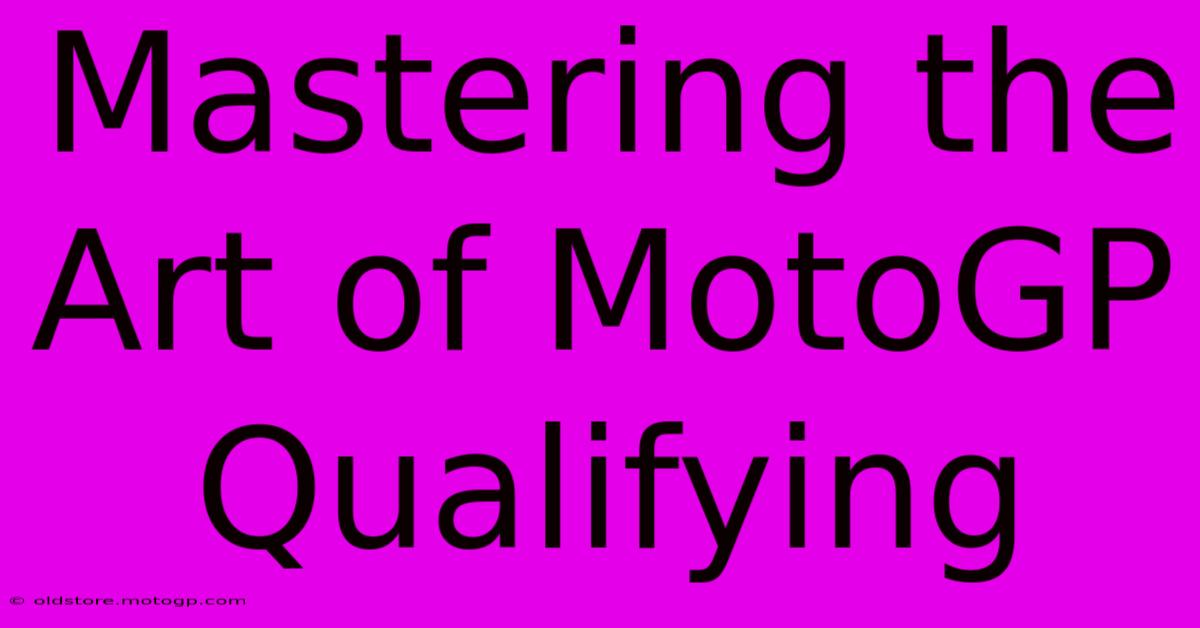Mastering The Art Of MotoGP Qualifying

Table of Contents
Mastering the Art of MotoGP Qualifying: From Grid Position to Race Victory
MotoGP racing isn't just about speed; it's about strategy, precision, and the relentless pursuit of milliseconds. And nowhere is this more evident than in qualifying. Securing a prime grid position can be the difference between a podium finish and a frustrating fight through the pack. This article delves into the intricacies of MotoGP qualifying, exploring the techniques, technology, and mental fortitude required to master this crucial stage of the race weekend.
Understanding the Qualifying Format
MotoGP qualifying is a multi-stage process designed to separate the fastest riders from the rest. It typically involves:
Free Practice (FP1-FP4): These sessions are crucial for gathering data, testing different bike setups, and finding the optimal race lines. While not technically part of qualifying, FP performance heavily influences a rider's confidence and preparedness for the qualifying sessions. Analyzing data from these sessions is key to success.
Q1 (Qualifying 1): The slower riders from the combined free practice times participate in Q1. This session is a high-pressure battle for a place in Q2. Only the top two riders from Q1 progress.
Q2 (Qualifying 2): The top ten riders from the combined free practice times, along with the two qualifiers from Q1, compete in Q2 to determine the starting grid positions for the race. The rider who sets the fastest lap time earns pole position.
Key Elements of a Successful MotoGP Qualifying Lap
A perfect qualifying lap is a symphony of precision and speed. Several key elements contribute to a rider's success:
Tire Management: Choosing the right tire compound and managing its wear throughout the qualifying session is vital. Overheating the tires can lead to a loss of grip, jeopardizing lap time. Experience and data analysis play a crucial role in this decision.
Track Conditions: Understanding the track temperature, grip levels, and even the wind conditions are crucial. Adjusting riding style and bike setup accordingly is a skill that comes with experience. Data analysis from previous sessions, coupled with rider feel, helps in adapting to changing conditions.
Slipstream: Drafting behind another rider (slipstreaming) can provide a significant speed advantage on straights, saving precious seconds. Strategic positioning during qualifying is crucial to take advantage of this. However, it requires precise timing and the risk of disrupting your own aerodynamic balance.
Brake Point and Turn Entry: Precision is key here. Finding the optimal brake point and entering the corner with the right speed and lean angle is paramount for achieving the best corner exit speed. This requires a deep understanding of the track and the bike's limits.
Race Setup vs. Qualifying Setup: While the race setup aims for consistency and tire longevity, a qualifying setup might prioritize speed over longevity, often using a more aggressive setup that maximizes lap time. This requires finding the optimal balance to ensure a fast lap while considering race implications.
The Mental Game of Qualifying
MotoGP qualifying isn't just a physical challenge; it's a mental battle. Riders must manage pressure, focus intensely, and maintain composure throughout the session. The ability to analyze data quickly, adapt to changing conditions, and execute flawlessly under intense pressure is crucial for success. Mental training and visualization techniques are commonly employed to enhance performance.
Technology's Role in Qualifying
Modern MotoGP technology plays a crucial role in maximizing performance during qualifying. Data acquisition systems provide riders and teams with detailed information about bike performance, tire wear, and rider input. This data helps optimize bike setups, improve riding techniques, and predict tire degradation. Sophisticated electronics, like traction control and anti-wheelie systems, further enhance control and stability, allowing riders to push harder without risking a crash.
Conclusion: The Pursuit of Perfection
Mastering the art of MotoGP qualifying is a continuous process of learning, adaptation, and refinement. It combines physical prowess, strategic thinking, and a deep understanding of technology. From managing tire wear and utilizing slipstreaming to harnessing the power of data and maintaining mental fortitude, every element contributes to securing that crucial grid position, setting the stage for a potential race victory. The pursuit of perfection is an ongoing journey, driven by the relentless quest for those crucial milliseconds that separate the champions from the contenders.

Thank you for visiting our website wich cover about Mastering The Art Of MotoGP Qualifying. We hope the information provided has been useful to you. Feel free to contact us if you have any questions or need further assistance. See you next time and dont miss to bookmark.
Featured Posts
-
Moto Gp Crash Today A Test Of Character
Feb 20, 2025
-
The Only Cota Merchandise Guide You Ll Ever Need
Feb 20, 2025
-
Elevate Your Racing Game Motorcycles For Sale
Feb 20, 2025
-
Feel The Speed Of Circuit Racing
Feb 20, 2025
-
Lub Si Cota Your Guide To Happiness
Feb 20, 2025
